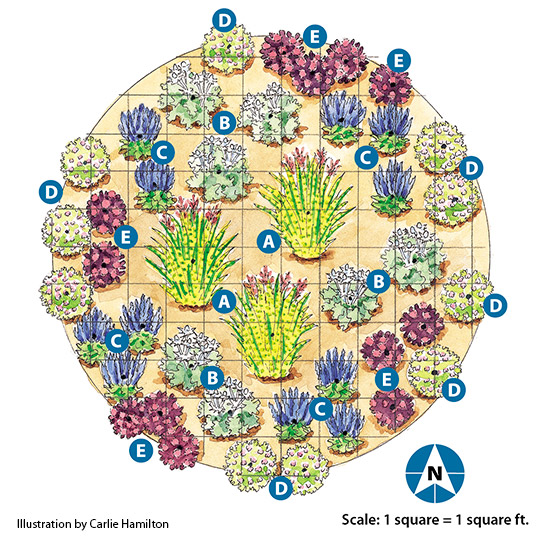 |
|
An easy-to-grow low-maintenance 5-plant perennial garden bed for busy people, weekend gardeners, and beginners. An easy 4-plant garden in pink can be found on this page. Basic Garden Color Theory - Handy for choosing plants in your favorite colors. Garden Gate magazine came up with a very easy perennial garden plan that's great for the newbie gardener to create as a single or multiple island bed design. You can use this design idea to create additional square or rectangular matching gardens by outlining the gardens with annuals and potted plants to create rectangle and square-shaped beds. This garden can grow as you do. If you wish to add some colorful annuals to pop in between the plants, it's easy to just place potted annuals or your own suitable houseplants among the perennials and add some more eye candy to your garden. Potted annuals means you can control their spread, and you can move them around or remove them as the perennials grow. Some annuals are suitable houseplants. Most of your houseplants would love to spend a summer outdoors under proper conditions, and you'd be surprised at their growth and good health. Below, you will find the planting diagram and a list of suggested perennials from Garden Gate magazine. You can choose any annuals you wish to fill in gaps or to outline your garden bed. My alternative plant list is included below. Add birdbaths and birdfeeder, and you have a lovely little bird habitat. Perennials listed come in all kinds of varieties. If you wish to switch some out with a more personalized pick or color, just choose another with the same growth and care attributes and needs, and be sure they will grow in your garden's hardiness zone. The plant label will tell you what zones that plant with thrive in. To find your plant hardiness zone, just check the USDA Cold Hardiness Zone Map.
Planting Key A. Maiden grass ‘Gold Bar’ Upright habit with horizontal gold
stripes on leaves; copper-pink late summer to fall flower heads B. Sea holly ’Sapphire Blue' A beautiful and unique-looking
plant. I've grown them, and they look awesome as accent or focal point
plants in any garden design. They are beautiful in large purple pots.
Spiny blue flowers in mid- to late summer with spiky foliage. Awesome as
a cut flower. **This plant is not happy being
transplanted, and has a long taproot, so be sure you plant it where you
ultimately want to keep it. C. Salvia ‘May Night’ Dark Lavender-blue flowers open in
early to midsummer that will bloom for two months Note: Salvia comes in many colors
and sizes - feel free to choose one or more types or colors. D. Cranesbill (Perennial Geranium) Light pink flowers in late spring,
reblooms Snow in Summer also looks beautiful
growing over or between rocks, tumbling over the base of a potted plant,
and as a filler for any garden spot that needs a little something
between plants. Trim as you wish to keep it growing in a particular way.
Mine blooms intermittently beginning in late spring and all through
summer. The foliage is ornamental even when the plant is not blooming. I
plant this at the base of my potted honeysuckle as a filler and spiller. E.
Sedum - ‘Lynda Windsor’ Dark burgundy leaves and stems on
a compact plant Alternative: I grow some to fill in the bare areas of soil at the bottoms of potted trees. Choose sedum that is less than the 18" tall suggested above - The fat, succulent stems will tend to flop over if too tall when it flowers. Mine average 10 inches tall. Somewhere between a ground cover and small plant. Needs no trimming, and t is drought tolerant. Rabbits seem to ignore it. To download a .pdf format copy of this design, click here. Harmonious colors
are next to each other on the color wheel and have a soothing effect.
These softer color combinations include blue and violet, orange and red,
and orange and yellow. Using harmonious colors unifies a garden while
still allowing a range of color. White flowers are in a color class by themselves. They blend well with every color and can also be used as a transition between colors that do not normally work well together. And yes, you can have white flowering plants after Labor Day. Like Hydrangeas, clematis, jasmine, Coneflowers, Chrysanthemums and Honeysuckle. Many hostas also feature pretty white flower stalks summer through fall. As do many ornamental grasses. Mix 'em up according to bloom time for a rotating flower show. Warm colors include red, orange and yellow. They tend to make flowers appear closer than they really are. Cool colors such as blue, violet, silver and white lend a calming effect and make plants appear farther away in the garden.
Easy Cottage Garden for Beginners--->
Easy Compact Vegetable Garden--->
Design, graphics,
articles and
photos ©2020 marysbloomers.com™ |
